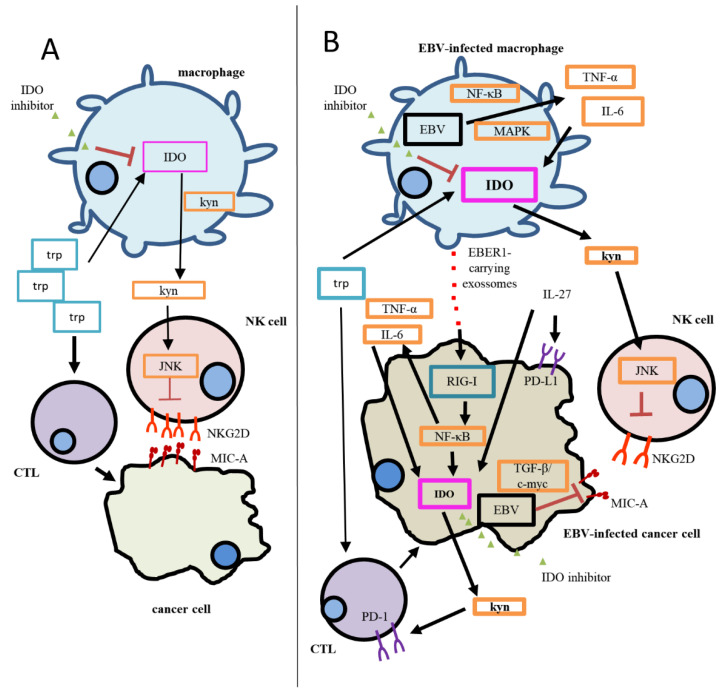Figure 1.
Proposed mechanism of the IDO-specific contribution to immunosuppression in EBV(−) cancer and EBV(+) cancer. (A) During homeostasis, CTLs utilize tryptophan in order to eliminate cancer cells. The degradation of tryptophan generates Kyn, which negatively contributes to NKG2D regulation of expression in NK cells. (B) EBV has been reported to increase IDO expression in infected cells; therefore, Trp degradation is enhanced, and so is Kyn accumulation. As a result, a more significant immunosuppression status is established, since CTL responses are inhibited, and stronger inhibition of NKG2D in NK cells can be observed. In addition, MIC-A, a NKG2D ligand, has been reported to be downregulated in EBV-infected cancer cells through the TGF-β/c-myc pathway. In this model, the activation of the RIG-I pathway through EBER1, delivered by exosomes, directly regulates IDO expression in cancer cells and/or also activates the NF-kB pathway in them, inducing the production of TNF-α and IL-6, culminating in the upregulation of IDO. The increased IDO expression in cancer cells would exacerbate the immunosuppression by increasing Trp utilization and Kyn accumulation. IL-27 would also play a role in this scenario, contributing to the expression of both IDO and PD-L1; the latter IC receptor expression, PD-1, increases on CD8+T cells as Kyn accumulates in the microenvironment. The use of specific IDO inhibitors would have a greater impact on EBV-associated malignancies, since IDO expression is higher when compared to EBV(−) cases. Thick lines represent stronger activation/expression than thin lines (weaker activation/expression). EBV: Epstein–Barr virus; CTL: cytotoxic T cell; JAK3/STAT3: Janus-kinase-3/signal transducer and activator of transcription-3; KYN: kynurenine; MAPK: mitogen-activated protein kinase; MIC-A: MHC class I polypeptide-related sequence A; NF-κB: nuclear factor-κB; NKG2D: NKG2-D type II integral membrane protein; PD-1: programmed cell death protein; PD-L1: programmed death-ligand 1; TGF-β/c-myc: transforming growth factor β/c-myc; TRP: tryptophan.

